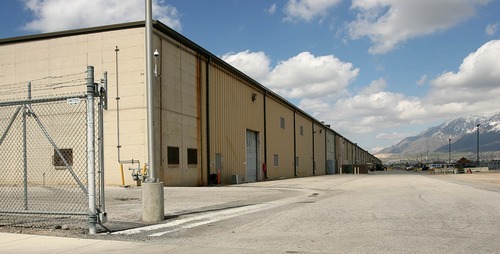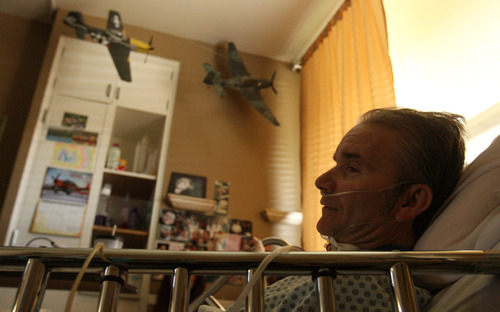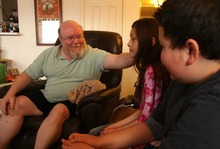This is an archived article that was published on sltrib.com in 2011, and information in the article may be outdated. It is provided only for personal research purposes and may not be reprinted.
Ling Seager is dead.
So is Jim Sproul, who sat next to her in an office in the Utah National Guard's Joint Language Training Center. And so is Chris Jensen, who sat beside Sproul.
Across from Seager sat Mike Chen; he survived a brain tumor. A few feet away was Mark Hepper; he's dying.
Megan Cate, Scott Forman, Jackie Leedy, Andy Swatsenbarg — all of them worked in the same small office. All of them are sick. None of them knows why.
Utah National Guard leaders say it's just a "weird coincidence" that so many people who worked in the same office at the center have died or become debilitatingly ill. Their investigation into environmental conditions at the facility, located at a sprawling industrial park in northern Utah, concluded that the office was safe for its workers — even as engineers continue to remove toxic chemicals from the ground surrounding the building in the middle of an Environmental Protection Agency Superfund site.
Swatsenbarg, a career Army officer who fell ill in 2007, isn't impressed with the military's self-examination.
"So the National Guard checked itself out and says everything is fine? Well, that's a big surprise," he says. "I wonder if Procter & Gamble could get away with that. Or how about Dow Chemicals or DuPont?"
Swatsenbarg and other veterans of the language center say they simply want to know that a serious effort has been made to ascertain whether their sicknesses are linked to their service. And that, they say, will take an investigation from someone outside of the Guard.
But so far, no one has been willing or able to help.
—
'I miss my life' • The soil and groundwater beneath Business Depot Ogden have been polluted with trichloroethylene, vinyl chloride, arsenic, lead, cadmium, mercury, barium and pesticides. The toxic mix of chemicals is the result of decades of cavalier disposal and burning of military-grade trash at the 1,100-acre former military facility, according to EPA records.
The agency added the campus — then known as Defense Depot Ogden — to its Superfund National Priorities List in 1987, and since then it has spent millions of dollars removing tainted soil and monitoring noxious plumes of groundwater. The cleanup continues, but the EPA has decided that the site "no longer poses any significant health risk." That declaration paved the way for a transfer of many of the buildings to the city of Ogden, which runs the business park with assistance from Utah's Boyer Corp. But the military retained a few buildings, including the quarter-mile-long warehouse, known as Building 11-C, that houses the Guard's language center.
Swatsenbarg knew about the cleanup when he helped move the language center to the depot in 1995 — about the same time that the military started up an elaborate pump-and-replacement system intended to cleanse the tainted groundwater around the building.
"I trusted that they wouldn't put us somewhere that was dangerous to our health," he says. "Honestly, I never even gave it a second thought."
These days, though, he thinks about it all the time.
Swatsenbarg is 46, but he knows he looks a decade or two older. The solid, muscular soldier in the photographs of his time in the Army — including a tour of duty in Iraq — has been replaced with an overweight, gray-bearded Santa Claus.
"I look like a blob," he says. "You wouldn't know it to look at me now, but I used to run five miles, three times a week. I was in good shape. I was an Army officer."
Then, one day, he arrived at work and noticed a sharp pain as he shook a colleague's hand. Soon the pain began to shoot up his arm. Before long his whole body was sore. He felt tired all the time.
At first the diagnosis was simple: Swatsenbarg had contracted human parvovirus — a common infection, often called "fifth disease," that usually resolves itself in a few days and, at worst, lasts for a few months.
But years after the infection, Swatsenbarg is still in pain. He sleeps for most of the day. When he's not sleeping, he's usually in his small living room, resting in a recliner next to a table stacked high with medicine bottles. He occasionally passes out in the middle of the apartment he shares part-time with his children, 12-year-old Justin and 8-year-old Rachel. His doctors have not been able to explain any of the symptoms.
"I miss my life," he says.
The sound of laughter comes from the next room over, punctuating Swatsenbarg's lament.
"My children, this is the father they have," he says. "The big, lumpy, sleeping guy. And it just makes me so sad."
Still, Swatsenbarg says, he should probably look on the bright side of things. "At least I'm still here," he says. "After all, three of my co-workers are dead."
And at least one more is almost certain to join them soon.
—
'I want him to keep fighting' • Mark Hepper wants to die.
"I'm ready to be done — I might as well," he says as he struggles to adjust his position beneath the web of tubes and wires that are keeping him alive at the Heritage Park Care Center in Roy. The 51-year-old is the youngest person there; some patients are nearly twice his age.
In the fall of 2006, Hepper was out for a run with some fellow soldiers "and I just couldn't manage to keep my balance," he says.
A brain scan showed Hepper had a malformation of the cerebellum, the part of the brain that controls balance. It sounded frightening, but his doctors assured him that the ailment, known as Arnold-Chiari Malformation, was relatively common. And, most importantly, it was treatable.
But Hepper didn't heal as expected after surgery. Instead, his body rapidly rejected the surgical interventions in a way that he says his doctors couldn't explain.
After 15 operations, a partial stroke and a weeklong coma, the former soldier spends most of his day lying on his hospital bed, staring up at a row of elaborate model airplanes that he built back when he had the strength and focus to do such intricate work.
"I always liked that sort of thing," he says. "I was the kind of person who had the patience for it."
Now, though, he is decidedly impatient. A machine helps him breathe. A nurse feeds him through a tube in his stomach. He sleeps most of the day, and the pain medications leave him groggy when he's awake.
"I just don't want to do this anymore," he says.
At his bedside — as she is nearly all the time these days — his wife Tiffany winces.
"To me, his attitude is that he's giving up," she says. "I want him to keep fighting. I really need him to."
After all, she says, she had just buried her sister when her husband fell ill.
Ling Seager worked at the desk next to her brother-in-law's at the language center, where both she and Hepper specialized in translating Asian languages, often in support of the military's intelligence-gathering operations.
She was energetic and fit. But in the winter of 2005 her health collapsed. It started with debilitating fatigue and a loss of appetite.
"She wasn't very big to begin with, and within six months she'd lost 30 or 40 pounds," Tiffany Hepper says. "Her skin turned black. And she was in a lot of pain."
Seager was 49 years old when she died June 15, 2006.
"The doctors couldn't even tell us what was wrong with her," Tiffany Hepper says.
—
A confident 'no' • Swatsenbarg caught parvo. Hepper had a congenital brain defect. And friends say that Sproul, who died on Aug. 15 at age 47, suffered from a form of cancer that ran in his family.
Clearly, Lt. Col. Bryce Taggart concluded in a report to Guard superiors, those sorts of ailments "are attributable to causes unrelated to" toxic exposure.
Taggart further found that air and drinking water samples taken and analyzed by independent experts in 2007 and 2010 did not reveal any contaminants above federal exposure limits. That corroborated the conclusions of Maj. Craig Bello, the deputy commander of the Guard's 85th Civil Support Team, who earlier had resolved that there was nothing more than "a weird coincidence of sicknesses that are present in the group."
"We can confidently say," Bello wrote to his superiors in 2010, "that it was not caused by working in the building."
In an email exchange from Iraq, where he is serving as a civil-military operations officer during the final stages of the withdrawal of U.S. troops, Taggart briskly answered questions about the depth of the investigation and how widely it was shared.
Did the investigation include anyone outside of the Joint Language Training Center?
"Just those who worked in the JLTC."
Were the results of the investigation shared with anyone outside the Guard?
"No."
But asked about his experience, Taggart was thorough. He began working as an environmental health scientist in 1980. He was project or operations manager for two environmental engineering firms between 1992 and 2004. He also oversaw environmental compliance programs for the National Guard in 54 states and territories. He has handled numerous site assessments and "complex soil and ground water investigations" throughout his career, he wrote.
Asked if that experience gave him any reason to be concerned about the environmental conditions at the language center, Taggart once again went with brevity.
"No," he wrote.
—
'Did we find everything?' • Scott Forman is proud of his career in uniform and wants to give his fellow soldiers the benefit of the doubt. But he's disappointed at their efforts.
"Look, I was fairly skeptical at first — I think everyone was," says Forman, who has suffered a rash of bladder, skin and liver ailments, all before his mid-50s. "I don't think any of us wanted to be whistle-blowers. We wanted to give the military a chance to check this out. But it's all seemed a bit whitewashed."
Among the complaints he shares with other language center veterans: No one from the Guard interviewed the sick individuals — let alone looked at any of their medical records. Taggart relied on the 2007 and 2010 air and water samples to determine that the office was and is safe — even though depot records show that chemical levels and the tainted-water table have fluctuated vastly from month to month and year to year. Some readings have shown chemicals at levels hundreds of times the target amounts for the cleanup. And aside from the small group of workers who voluntarily identified themselves as ill, no one sought to find out if anyone else from the office — or any of its surrounding work spaces — was sick.
"We just want to know that they did everything they could to get to the answers," Forman says. "Even if everything really is fine. I can easily be comfortable if that is, in fact, the truth. But what I want to know is, was this investigation done right?"
The Utah Guard's chief spokesman, Lt. Col. Hank McIntire, said investigators would have dug deeper if they had cause to do so, but the Guard-sponsored inquiry — reviewed by "independent, state, and federal entities" — found no evidence of materials that could be linked to health issues. Medical records weren't reviewed, he said, because "the investigation established no causal link between conditions in the facility and health issues reported."
The office where the sick veterans worked was recently closed, but McIntire insists "the decision was in no way connected with the investigation in question." A reduction in manpower at the center made the office unnecessary, he says.
Charts of the levels of toxic chemicals in the depot's groundwater show that remediation efforts are working. A plume of vinyl chloride that extended well below building 11-C in 1995, for instance, is now nearly undetectable.
But Larry McFarland, an Army environmental engineer responsible for overseeing the ongoing groundwater cleanup, says small "hot spots" abound at the depot. "Did we find everything? I'm the first to tell you that we didn't," he says.
Boyer Corp. spokesman Steve Waldrip says his company was surprised when it learned — from The Salt Lake Tribune — about the workers' concerns. The military, he says, "hasn't communicated anything with us at all."
Although the building isn't part of Boyer's inventory, the company would have appreciated knowing about the investigation and its results. "We have a full disclosure policy with all of our tenants," he says.
When trying to build trust atop a Superfund site, he said, "we have to be transparent."
—
'We have not heard any complaints' • Muhammad Slam, project manager for the Utah Department of Environmental Quality, says he was sympathetic when he learned last year about the plights of the former language center workers.
He doesn't dismiss their concerns. But he notes the business depot has dozens of tenants, from a composites manufacturer to a nutritional supplements enterprise to a sporting apparel company, "and we have not heard any complaints from any of the other tenants."
The Utah DEQ oversees the cleanup of contaminants outdoors, he adds, and indoor contamination is the responsibility of the Occupational Safety and Health Administration.
Herb Gibson, area director for the OSHA region that includes Utah, says he sent an investigator to Ogden to talk to a few of the language center's civilian staffers last year. But OSHA is statutorily prohibited from investigating complaints from uniformed members of the military — so investigators couldn't talk to the ill workers.
OSHA is concerned about workers' past exposures, he says, but it operates under a six-month statute of limitations. "Our regulatory scheme deals with what they are currently exposed to."
His agency did what it could, he says, and didn't find any signs that the center's few civilian workers were sick.
Jim Kiefer, who oversees the Ogden cleanup effort for the EPA, has taken calls about the workers' illnesses. But he also concluded that OSHA has jurisdiction — and says he assumed it "was working on the complaint."
The closest known plume of groundwater contaminants is now hundreds of feet away from Building 11-C, he notes, and the level of chemicals in that area are well below the point that could be expected to make anyone sick.
He "walked through every building at the depot" in the mid-1990s, he says, and believed the structures were safe to use — with a few safety caveats.
One such restriction: "They can't drill through the floor and cause a pathway for vapors to get into the building."
That triggers a memory for Swatsenbarg, the Army officer who helped moved the language center to the depot. As he and others tore out an old floor during renovations, he recalls, they found copper plates that they suspected had once been used during industrial electrical work.
"We found industrial rubber gloves and a hook that we guessed was used to pull people away if they were being electrocuted," he says. "But the important thing was those plates, they had been bolted to the floor — right through the concrete."
Dave Allison, community involvement coordinator for the Utah DEQ, took interest in that detail, though he remains noncommittal about any further investigation. He notes the depot site is due for a federally mandated "five-year review" next year, and says the language center illnesses "might be something that pops up" at that time.
—
Difficult to prove a connection • Terry Nordbrock sees a fairly simple way for the Utah National Guard to develop trust and legitimacy for its investigation, and perhaps even some answers.
"It would be really nice to get all of the players together," says Nordbrock, who leads the National Disease Clusters Alliance in Tucson, Ariz. "The EPA, OSHA and the state of Utah — they're all are sort of thinking that someone else is responsible, but what if they were able to be at the table together?"
All it would take, she suggests, is an invitation from the Guard.
The sick veterans should have a seat and their health records should be reviewed by medical professionals, she says. But even under the best of situations, she concedes, it's difficult to prove a connection between a cluster of illnesses and a cause.
That's especially true, she adds, when multiple hazardous chemicals are involved, and its further complicated by the fact "that there are significant variations between people in the way they react" to toxic substances.
Still, she believes the government — and particularly the military — typically washes over the concerns of those who believe their illnesses may be linked to a common cause; meanwhile, people are prone to simply accept that the government is protecting them from harm.
Among the tenants at the quickly expanding business depot are Flying J Restaurants, Lofthouse Foods, Otis Spunkmeyer cookies and — a new addition in the past few months — Depot Day Care. The child-care center's owner, Al Arnold, says it's "common knowledge around the depot" that some employees on depot grounds have become sick, and others have died. He had heard the issue was being investigated from "somebody who told somebody that told somebody."
But if something were really wrong, he figures, someone in charge would say something about it.
"I wouldn't have opened it here if I had any concerns," he says.
Steve Erickson has trouble understanding why many Utahns are so confident that the military is looking out for them. Erickson, who advocates on behalf of Utah's nuclear "downwinders" and others who believe they may have been harmed by military tests, operations and experiments, says that if people don't advocate for themselves, history shows that government won't do it for them.
"There's always resistance — there's always skepticism and denial," he says. "That was the response to Legionnaires' Disease, to Chronic Fatigue Syndrome and maybe the best example is Gulf War Illness. In all of these cases, there were all of these symptoms and they were kind of vague and scattered and ill-defined, which raises that skepticism. But then, we've seen the way these illnesses play out to be true, haven't we?"
—
'I'm in pain' • Megan Kimball Cate has crossed the country seeking answers. She's still waiting.
As a Farsi linguist at the language center, Cate figured she could always count on a military paycheck. "As long as the Iranians kept making trouble, I had job security," she says.
But in summer 2009 — with Iran's theocratic government drawing scrutiny over nuclear weapons and contested elections — Cate's suddenly failing health pushed her to the sidelines.
It started with a dull headache. Soon Cate was suffering from convulsions in her sleep.
She had trouble keeping her balance. Her bones and joints ached. She couldn't stay awake. Her muscles flexed and twitched involuntarily. Already trim at 123 pounds, the 5-foot-5 Utah Air National Guard member lost nearly a quarter of her body weight in a few short months.
No one has been able to diagnose her condition.
She's 35 years old.
"I'm in pain every single moment of every single day," Cate says from her home in Virginia, where her family moved, in part, to seek better care for her. "I can't walk properly … I can't go to the grocery store, to a museum, without a wheelchair or a scooter."
But she insists that her biggest concern is the people still working in that building. "If there are chemicals there that made us all sick," she says, "then they could be making other people sick, too."
Guard colleagues say Cate's symptoms closely resemble Seager's terminal illness. And that terrifies Cate's husband, Joe.
"Our son is 6 and our daughter is 4," he says. "It's difficult to look at the future and realize that she might not be here, but that might be our reality."









